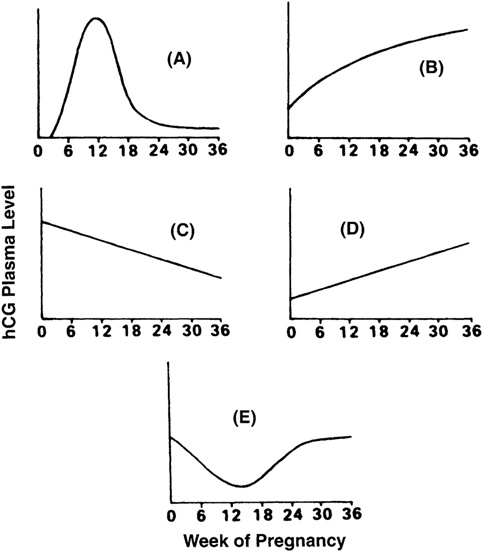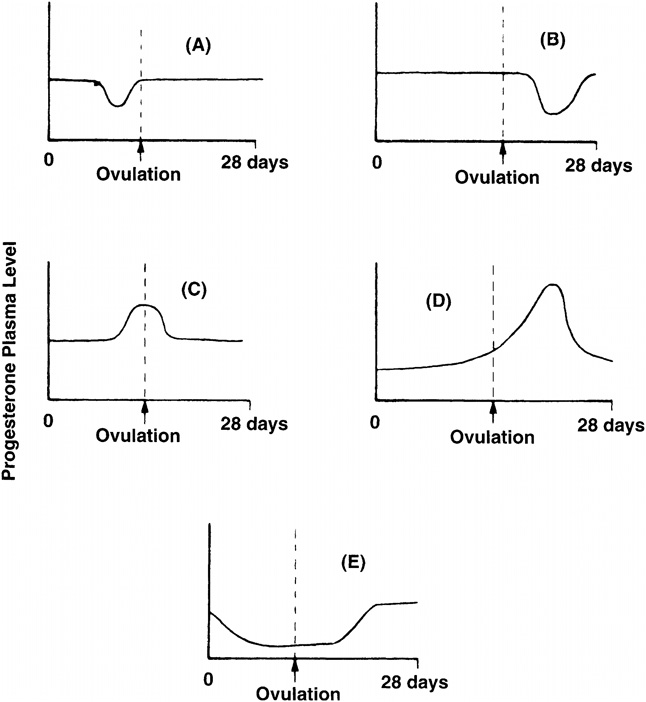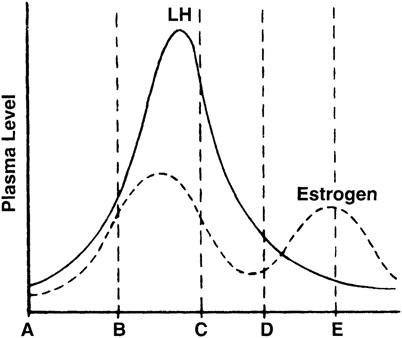a. Early proliferative phase
b. Menses
c. Mid-luteal phase
d. Ovulation
e. Secretory phase
436. A 15-year-old boy presents for his annual athletic physical exam. A thorough examination reveals unilateral cryptorchidism. The physician schedules a follow-up visit with the boy and his parents to discuss his recommendation for surgery to correct the defect because of his concerns of possible infertility in the future. Which of the following best describes spermatogenesis?
a. Leydig cell secretion of testosterone requires follicle-stimulating hormone (FSH).
b. Luteinizing hormone (LH) acts directly on Sertoli cells to promote cell division.
c. Mature spermatozoa are present at birth, but cannot be released until puberty is reached.
d. Spermatogenesis requires a temperature lower than internal body temperature.
e. Spermatogenesis requires continuous release of gonadotropin-releasing hormone (GnRH).
437. A 19-year-old female presents to her primary care physician with significant weight loss and secondary amenorrhea. She has a high-intensity exercise regimen, is preoccupied with food, and seems to have an irrational fear of gaining weight. Decreased production of which of the following hormones leads to amenorrhea in anorexia nervosa?
a. Human chorionic gonadotropin (hCG)
b. Estradiol
c. Gonadotropin releasing hormone (GnRH)
d. Progesterone
e. Prolactin
438. A 32-year-old man taking chlorpromazine for his schizophrenia presents with diminished libido and decreased beard growth. His blood prolactin level of 75 μg/L confirms the diagnosis of hyperprolactinemia. Which of the following is true regarding prolactin?
a. Prolactin causes milk ejection during suckling.
b. Prolactin inhibits GnRH secretion by the hypothalamus.
c. Prolactin inhibits gonadotropin secretion by the pituitary gland.
d. Prolactin inhibits growth of breast tissue.
e. Serum prolactin levels are much higher in women than in men.
439. A 22-year-old woman presents to the obstetrician-gynecologist’s office with complaints of painful menstruation accompanied by profuse menstrual flow. The doctor prescribes ibuprofen and an oral contraceptive. Biological actions of estrogens include a decrease in which of the following?
a. Duct growth in the breasts
b. Libido
c. Ovarian follicular growth
d. Serum cholesterol levels
e. Uterine smooth muscle motility
440. A 34-year-old woman discovers that she is pregnant using a home pregnancy test that detects the presence of hCG in the urine. Which of the curves shown below approximates the level of this hormone during pregnancy?

a. A
b. B
c. C
d. D
e. E
441. A 26-year-old man with Klinefelter’s syndrome has seminiferous tubule dysgenesis. Which of the following is a function of Sertoli cells in the seminiferous tubules?
a. Expression of surface LH receptors
b. Maintenance of the blood–testis barrier
c. Secretion of FSH into the tubular lumen
d. Secretion of testosterone into the tubular lumen
e. Synthesis of estrogen after puberty
442. A 23-year-old woman who has been training for a marathon presents with secondary amenorrhea. A pregnancy test is negative, so the woman is started on the orally active opioid blocker naltrexone, which restores ovulation and menses. Ovulation is caused by a sudden increase in the secretion of which of the following hormones?
a. Estrogen
b. FSH
c. GnRH
d. LH
e. Progesterone
443. An 18-year-old college woman is brought to the emergency department by her roommate after she was raped walking back to the dorm from the library at night. She requests the “morning after pill” she has heard about to prevent pregnancy from the violation. She is given a postcoital contraceptive to prevent implantation and induce regression of the corpus luteum. Which of the following best describes implantation of the zygote in the uterine wall?
a. Involves infiltration of the endometrium by the syncytiotrophoblast
b. Is inhibited by secretion of progesterone from the corpus luteum
c. Occurs 3 to 5 days after fertilization
d. Occurs when the embryo consists of approximately 128 cells
e. Precedes formation of the zona pellucida
For Questions 444 and 445, refer to the following case.
A 28-year-old woman develops nausea and breast tenderness after missing her menstrual period. A digital home pregnancy test is positive. Other than lower back pain, occasional headaches, and frequent urination, the pregnancy progresses to the second trimester without complications.
444. With respect to hormonal changes during pregnancy, which of the following is the source of estrogen and progesterone during the first 2 months of pregnancy?
a. Anterior pituitary
b. Corpus luteum
c. Ovary
d. Placenta
e. Posterior pituitary
445. Which of the following is the source of estrogen and progesterone during the last 7 months of pregnancy?
a. Anterior pituitary
b. Corpus luteum
c. Ovary
d. Placenta
e. Posterior pituitary
446. A woman presents to her obstetrician with concerns that she has had trouble breast feeding. She reports that her mother-in-law told her that beer would relax her and allow her milk to flow more readily, but it has not helped, even with drinking up to a six pack a day. Which of the following hormones is involved in the ejection of milk from a lactating mammary gland?
a. Estrogen
b. Growth hormone
c. Oxytocin
d. Progesterone
e. Prolactin
447. The normal pattern of progesterone secretion during the menstrual cycle is exhibited by which of the following curves?

a. A
b. B
c. C
d. D
e. E
For Questions 448 and 449, refer to the following case.
A 30-year-old woman with polycystic ovarian syndrome uses an estrogen/progesterone combination for androgen excess and endometrial protection.
448. Administration of estrogens in women will do which of the following?
a. Cause cervical mucus to become thicker and more acidic
b. Decrease bone density
c. Limit the growth of ovarian follicles
d. Produce cyclic changes in the vagina and endometrium
e. Retard ductal proliferation in the breast
449. Which of the following best describes progesterone?
a. Plasma levels of progesterone increase during menses.
b. Plasma levels of progesterone decrease after ovulation.
c. Plasma levels of progesterone remain constant after implantation.
d. Progesterone is secreted by the corpus luteum.
e. Progesterone secretion by the placenta increases at week 6 of gestation.
450. A young couple presents with concerns that they have not been able to conceive a child. Physical examination of the 22-year-old husband reveals mild obesity, gynecomastia, and decreased facial and axillary hair. He has male genitalia, but penile length is decreased and the testes are small. Chromosomal analysis reveals the XXY pattern of Klinefelter’s syndrome. Which of the following is the principal androgen responsible for transforming undifferentiated external genitalia in the fetus into male external genitalia?
a. Androstenedione
b. Androsterone
c. Dihydrotestosterone
d. Müllerian-inhibiting substance (MIS)
e. Testosterone
451. A 12-year-old girl presents to her pediatrician’s office because she has not yet begun her menstrual periods and she lacks breast development. After evaluation, she is found to have Turner’s syndrome. Which of the following best describes a patient with Turner’s syndrome?
a. It is not associated with hypothyroidism.
b. It is not associated with renal abnormalities.
c. Ovarian dysgenesis (streak ovary) is characteristic.
d. Tall stature is common.
e. The most common karyotype is 45,X/46,XX mosaicism.
452. A 55-year-old woman is experiencing the signs and symptoms of menopause. Her gynecologist discusses with her the possibility of hormone replacement therapy (HRT). Which of the following are effects of postmenopausal HRT?
a. Increases the risk of osteoporosis
b. Reduces the incidence of hot flashes
c. Reduces the risk of breast cancer
d. Reduces the risk of coronary artery disease and stroke
e. Returns the menstrual cycle pattern to normal
453. A 29-year-old woman delivers a 7-lb 6-oz baby girl without complication. She begins to produce and eject breast milk a few days later. Prolactin secretion is tonically suppressed in nonpregnant women by which of the following hormones?
a. Dopamine
b. Estrogen
c. FSH
d. LH
e. Progesterone
454. A young couple has been trying to conceive a baby. The medical director of the fertility center has advised the woman to take her basal temperature readings on a daily basis and for them to have intercourse at the time the woman appears to be ovulating. Once conception takes place, which of the following must occur in order for the pregnancy to proceed uneventfully?
a. The corpus luteum must secrete progesterone to sustain the endometrium.
b. The pituitary must secrete hCG to maintain the corpus luteum.
c. The pituitary must secrete prolactin to sustain the placenta.
d. The placenta must secrete FSH to maintain ovarian function.
e. The placenta must secrete LH to maintain ovarian function.
455. A 32-year-old woman presents at her physician’s office complaining of nausea and vomiting. The history reveals that her symptoms have been present for over a month and that they seem to be worse in the morning. A urine sample is taken and shows that the woman is pregnant. Physiological changes that occur during pregnancy include which of the following?
a. Decreased production of cortisol and corticosterone
b. Hypercapnia
c. Increased conversion of glucose to glycogen
d. Increased hematocrit
e. Reduced circulating gonadotropin levels
456. A couple presents at the fertility center with concerns that they have not been able to conceive a child. The reproductive endocrinologist evaluates the wife to be certain that she is ovulating. Which of the following is an indication that ovulation has taken place?
a. A drop in body temperature
b. An increase in serum estrogen levels
c. An increase in serum FSH levels
d. An increase in serum LH levels
e. An increase in serum progesterone levels
457. In the graph below showing plasma hormone levels as a function of time, ovulation takes place at which of the lettered points on the time axis?

a. A
b. B
c. C
d. D
e. E
458. A 35-year-old woman presents to her obstetrician/gynecologist’s office for her annual well-woman examination. She reports that she may have “a touch of the flu” because she has been tired and nauseated the past week and also has had fleeting episodes of lower abdominal pain. She wasn’t sure when her last menstrual period started but, after looking at a calendar, realized that it had been 38 days. A right adnexal mass was palpated on routine pelvic examination and subsequently observed on ultrasound. Urinalysis confirmed that the woman was pregnant and serum levels of the tumor marker CA-125 were elevated. The gynecologist informed the woman that she may have an ovarian cancer and may need her ovary removed, but that they need to wait another week or two to do the laparotomy in order to protect her fetus. Ovariectomy before the 6th week of pregnancy leads to abortion, but thereafter has no effect on pregnancy because the placenta secretes adequate amounts of which of the following hormones?
a. Estrogens and progesterone
b. Estrogen and relaxin
c. Growth hormone–releasing hormone and corticotropin-releasing hormone
d. Human chorionic somatomammotropin and hCG
e. Progesterone and hCG
459. A 54-year-old man is prescribed finasteride, a 5-alpha reductase inhibitor, for his benign prostatic hypertrophy. Why is his pregnant wife instructed to not even handle the medication?
a. Blocking the production of dihydrotestosterone will interfere with normal sexual differentiation of the penis, scrotum, and prostate in male fetuses.
b. Inhibiting 5-alpha reductase in utero will impair SRY gene expression and consequently development of the testes.
c. Inhibiting 5-alpha reductase in utero will lead to precocious puberty in both sexes.
d. Inhibiting 5-alpha reductase in utero impairs secretion of MIS.
e. Inhibiting 5-alpha reductase in utero will cause regression of the Wolffian ducts such that a male fetus develops female genitalia.
Stay updated, free articles. Join our Telegram channel

Full access? Get Clinical Tree


